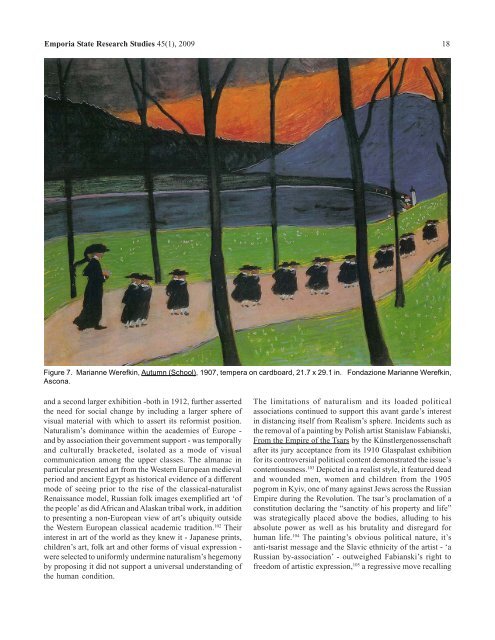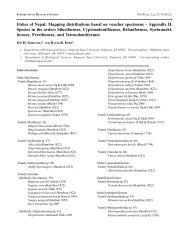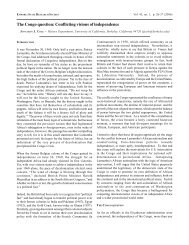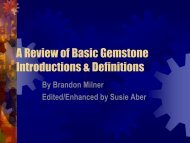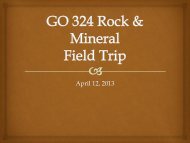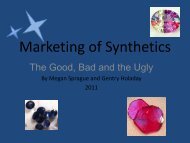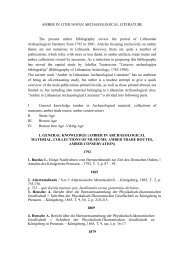Kochman 17Figure 6. Alexei Jawlensky, Girl with the Green Face, 1910,oil on composition board, 20 15/16 x 19 9/16 <strong>in</strong>. Gift of Mr.<strong>and</strong> Mrs. Earle Ludg<strong>in</strong> <strong>in</strong> memory of John V. McCarthy, ArtInstitute of Chicago, © 2009 Artists Rights Society (ARS),New York / VG Bild-Kunst, Bonn.world - parallels Levitan’s mo<strong>de</strong>l for visualiz<strong>in</strong>g the <strong>in</strong>herentproperties of l<strong>and</strong>scape, as discussed earlier <strong>in</strong> Gol<strong>de</strong>nAutumn. Slobodka. Both <strong>artists</strong> focus on the <strong>in</strong>herentcharacteristics of the liv<strong>in</strong>g object they are <strong>de</strong>pict<strong>in</strong>g, whetherplant or human, <strong>and</strong> sought to translate the organic forcewhich drives their existence visually. Levitan’s isolation ofheightened color <strong>in</strong> particular areas of his l<strong>and</strong>scape wasanalogous to this <strong>in</strong>ternal property <strong>and</strong> exp<strong>and</strong>ed upon <strong>in</strong>Jawlensky’s <strong>in</strong>terpretation of the <strong>in</strong>dividual. For Jawlensky,color <strong>in</strong>tensity, l<strong>in</strong>e saturation <strong>and</strong> weight served asmeasurable behavioral markers of the sitter, pa<strong>in</strong>terly vehiclesof communication impart<strong>in</strong>g essential knowledge of thehuman character captured at the moment of his <strong>in</strong>terpretation<strong>and</strong> visual rendition.Like Jawlensky, Werefk<strong>in</strong> was <strong>in</strong>terested <strong>in</strong> nature as areference for explor<strong>in</strong>g the <strong>in</strong>ternal world. This conta<strong>in</strong>edanecdotal components, as <strong>in</strong> schoolgirls tak<strong>in</strong>g an outdoorstroll <strong>in</strong> Autumn (School) 1907 (Fig. 7) however un<strong>in</strong>ten<strong>de</strong>dfor conventional narrative <strong>in</strong>terpretation. The natural worldis ren<strong>de</strong>red <strong>in</strong> a sublime state - dark blue lake <strong>and</strong> mounta<strong>in</strong>,th<strong>in</strong>ly outl<strong>in</strong>ed <strong>in</strong> white <strong>and</strong> lighter blue <strong>and</strong> complementedby an <strong>in</strong>tensely saturated orange to red sky. Another blackgreenmounta<strong>in</strong> on the left is flanked by a th<strong>in</strong>ly applied darkgreen shore below <strong>and</strong> <strong>in</strong> the sky beyond the mounta<strong>in</strong>top.The sett<strong>in</strong>g suggests a strik<strong>in</strong>g sunset <strong>in</strong> its heightenedcoloration but also challenges this traditional conclusion <strong>in</strong>its stylistic manifestation. Werefk<strong>in</strong>’s calls attention to theschoolgirls’ relationship with their surround<strong>in</strong>gs by offsett<strong>in</strong>gthe darkened horizontal areas across the background withthe black cloth<strong>in</strong>g they wear, black trees lend<strong>in</strong>g ad<strong>de</strong>d <strong>de</strong>pth,vertical visual structure <strong>and</strong> a tangible visual connectionbetween both realms through black pigment. The stu<strong>de</strong>nts’placement with<strong>in</strong> the trees on a <strong>de</strong>signated path suggests theyare somewhat protected from nature’s allure <strong>and</strong> mystery, yetalso embraced by it <strong>in</strong> the larger sphere. Werefk<strong>in</strong>’s belief <strong>in</strong>the universality of art <strong>in</strong> life <strong>and</strong> it’s presence <strong>in</strong> nature istransferred to her presentation of the young schoolgirls who,currently <strong>in</strong> their formative educational years, will lookforward to experienc<strong>in</strong>g all life has to offer <strong>in</strong> their future.Her focus on organic processes of nature, whether humangrowth <strong>and</strong> <strong>de</strong>velopment or changes <strong>in</strong> the physical worldma<strong>de</strong> up her world view <strong>and</strong> art’s role <strong>in</strong> it. She stated, “No,[the purpose of] art isn’t for sell<strong>in</strong>g pa<strong>in</strong>t<strong>in</strong>gs, but so thatpeople can un<strong>de</strong>rst<strong>and</strong> what is happen<strong>in</strong>g <strong>in</strong> the world <strong>and</strong>what the [art] works communicate, <strong>and</strong> what makes the l<strong>and</strong>breathe <strong>and</strong> what [pattern] is be<strong>in</strong>g cut <strong>in</strong> life. And thatknowledge, agoniz<strong>in</strong>g <strong>and</strong> sweet, comm<strong>and</strong><strong>in</strong>g <strong>and</strong>mur<strong>de</strong>rous, unnecessary <strong>and</strong> unequally precious is God’sgreatest gift to man.” 98Differences regard<strong>in</strong>g the optimal artistic strategy with whichto pursue their reformist goals with<strong>in</strong> the NKVM ultimatelydissolved the group <strong>in</strong> 1912. The NKVM jury’s rejection ofK<strong>and</strong><strong>in</strong>sky’s Composition V, 1911 on the grounds of excessivesize prompted his resignation <strong>in</strong> December 1911, althoughissues regard<strong>in</strong>g the <strong>de</strong>gree of abstraction its members shouldfollow appears to have been at the center of theirdisagreement. 99 Jo<strong>in</strong><strong>in</strong>g him <strong>in</strong> resignation were Franz Marc,Gabriele Münter <strong>and</strong> Alfred Kub<strong>in</strong> <strong>and</strong> two weeks later thefirst Der Blaue Reiter exhibition opened <strong>in</strong> two roomsadjacent to the NKVM’s third <strong>and</strong> f<strong>in</strong>al show at the GalerieThannhauser <strong>in</strong> <strong>Munich</strong>. 100 Lead by K<strong>and</strong><strong>in</strong>sky <strong>and</strong> Marc,Der Blaue Reiter’s commitment to embrac<strong>in</strong>g a broa<strong>de</strong>rartistic vocabulary with which to achieve its reformist missionwas stated <strong>in</strong> the open<strong>in</strong>g page of its first catalogue. “In thissmall exhibition we seek not to propag<strong>and</strong>ize a precise <strong>and</strong>particular style but <strong>in</strong>tend to show <strong>in</strong> the difference ofrepresented mo<strong>de</strong>s how diversely the <strong>in</strong>ner <strong>de</strong>sire of the artistis fashioned.” 101The exhibition featured <strong>artists</strong> oriented towards a shared belief<strong>in</strong> non-naturalist communication through elements of color,form, l<strong>in</strong>e <strong>and</strong> spatial <strong>de</strong>pth <strong>in</strong> vary<strong>in</strong>g <strong>de</strong>grees of abstraction.Works by Henri Rousseau <strong>and</strong> Eugen Kahler were shownposthumously, as well as those of Robert Delaunay, ArnoldSchönberg <strong>and</strong> August Macke. Brothers David <strong>and</strong> VladimirBurliuk, who had exhibited with the NKVM <strong>in</strong> 1910, werealso <strong>in</strong>clu<strong>de</strong>d. Subsequent Der Blaue Reiter productions, itswell-known almanac of essays <strong>and</strong> accompany<strong>in</strong>g images,
Emporia State Research Studies 45(1), 2009 18Figure 7. Marianne Werefk<strong>in</strong>, Autumn (School), 1907, tempera on cardboard, 21.7 x 29.1 <strong>in</strong>. Fondazione Marianne Werefk<strong>in</strong>,Ascona.<strong>and</strong> a second larger exhibition -both <strong>in</strong> 1912, further assertedthe need for social change by <strong>in</strong>clud<strong>in</strong>g a larger sphere ofvisual material with which to assert its reformist position.Naturalism’s dom<strong>in</strong>ance with<strong>in</strong> the aca<strong>de</strong>mies of Europe -<strong>and</strong> by association their government support - was temporally<strong>and</strong> culturally bracketed, isolated as a mo<strong>de</strong> of visualcommunication among the upper classes. The almanac <strong>in</strong>particular presented art from the Western European medievalperiod <strong>and</strong> ancient Egypt as historical evi<strong>de</strong>nce of a differentmo<strong>de</strong> of see<strong>in</strong>g prior to the rise of the classical-naturalistRenaissance mo<strong>de</strong>l, <strong>Russian</strong> folk images exemplified art ‘ofthe people’ as did African <strong>and</strong> Alaskan tribal work, <strong>in</strong> additionto present<strong>in</strong>g a non-European view of art’s ubiquity outsi<strong>de</strong>the Western European classical aca<strong>de</strong>mic tradition. 102 Their<strong>in</strong>terest <strong>in</strong> art of the world as they knew it - Japanese pr<strong>in</strong>ts,children’s art, folk art <strong>and</strong> other forms of visual expression -were selected to uniformly un<strong>de</strong>rm<strong>in</strong>e naturalism’s hegemonyby propos<strong>in</strong>g it did not support a universal un<strong>de</strong>rst<strong>and</strong><strong>in</strong>g ofthe human condition.The limitations of naturalism <strong>and</strong> its loa<strong>de</strong>d <strong>political</strong>associations cont<strong>in</strong>ued to support this avant gar<strong>de</strong>’s <strong>in</strong>terest<strong>in</strong> distanc<strong>in</strong>g itself from Realism’s sphere. Inci<strong>de</strong>nts such asthe removal of a pa<strong>in</strong>t<strong>in</strong>g by Polish artist Stanislaw Fabianski,From the Empire of the Tsars by the Künstlergenossenschaftafter its jury acceptance from its 1910 Glaspalast exhibitionfor its controversial <strong>political</strong> content <strong>de</strong>monstrated the issue’scontentiousness. 103 Depicted <strong>in</strong> a realist style, it featured <strong>de</strong>ad<strong>and</strong> woun<strong>de</strong>d men, women <strong>and</strong> children from the 1905pogrom <strong>in</strong> Kyiv, one of many aga<strong>in</strong>st Jews across the <strong>Russian</strong>Empire dur<strong>in</strong>g the Revolution. The tsar’s proclamation of aconstitution <strong>de</strong>clar<strong>in</strong>g the “sanctity of his property <strong>and</strong> life”was strategically placed above the bodies, allud<strong>in</strong>g to hisabsolute power as well as his brutality <strong>and</strong> disregard forhuman life. 104 The pa<strong>in</strong>t<strong>in</strong>g’s obvious <strong>political</strong> nature, it’santi-tsarist message <strong>and</strong> the Slavic ethnicity of the artist - ‘a<strong>Russian</strong> by-association’ - outweighed Fabianski’s right tofreedom of artistic expression, 105 a regressive move recall<strong>in</strong>g


